|
Priscilla's
Bird Photography
|

|
|
During the long stretch of very cold foggy days we had in January 2014, my friend Beth saw a Great Horned Owl in a fir tree just outside her house.
In her own words, (as she wrote to me)
"1/14/2014; 9:20 am Tuesday; cold, foggy morning. I watched /followed the very noisy crows and found this beauty with my binocs.
Great Horned Owl (solo) large fir tree ..."
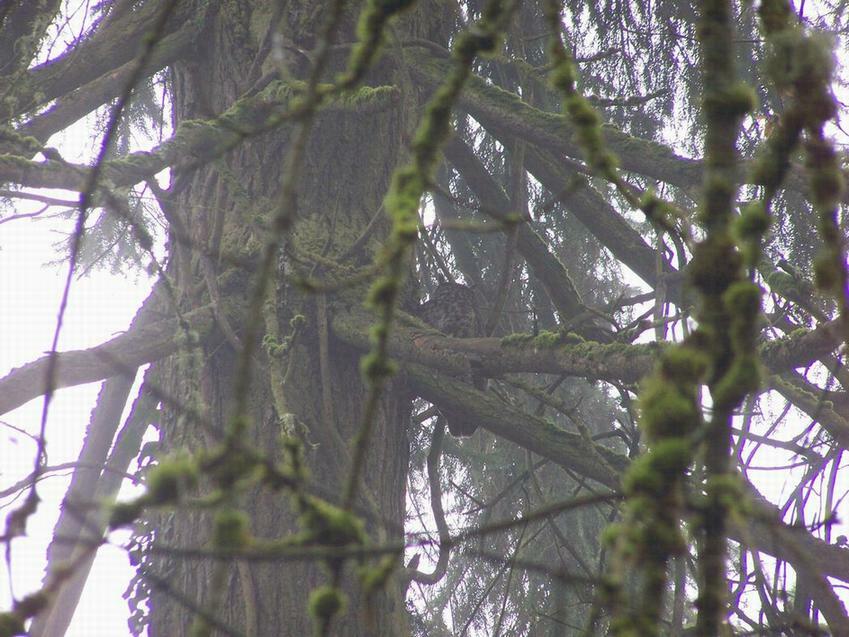
I did some post-processing of this photo to see if I could bring out any color or details:
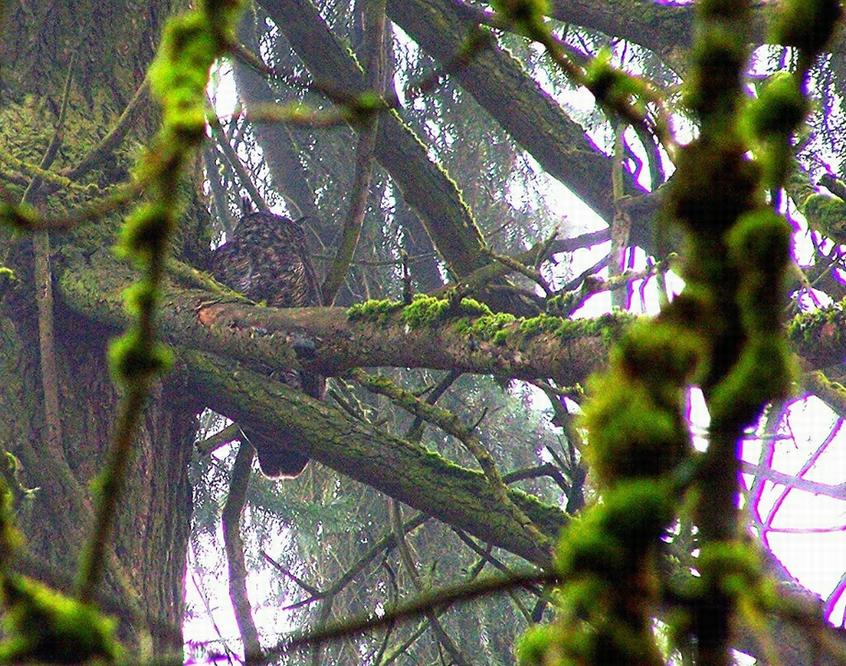
|
|
A few days later, Beth recorded:
"1/18/2014; 4:20 pm Saturday; cold, foggy . No crows. Very quiet. I was looking...(no binocs) aha! what luck! Great Horned Owl; wooded area near our fence ... mostly deciduous trees."
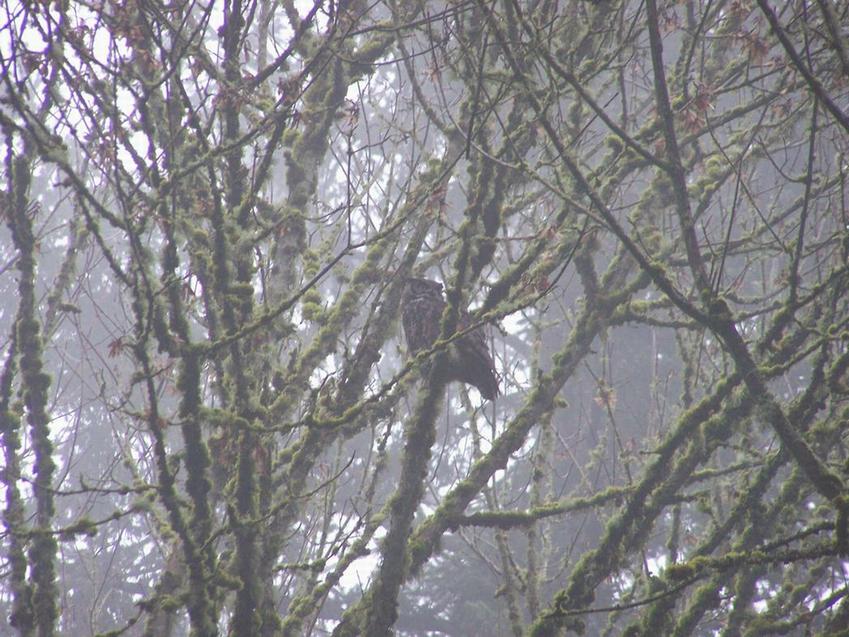
After Beth shared this picture with me, I brightened the image to get as much detail and color as I could get
from it. I've overdone it really, but ....

|
|
Then, later that same day; Beth recorded more in her journal:
"1/18/2014; 04:23 pm; Flying (approx 10 feet to another tree)
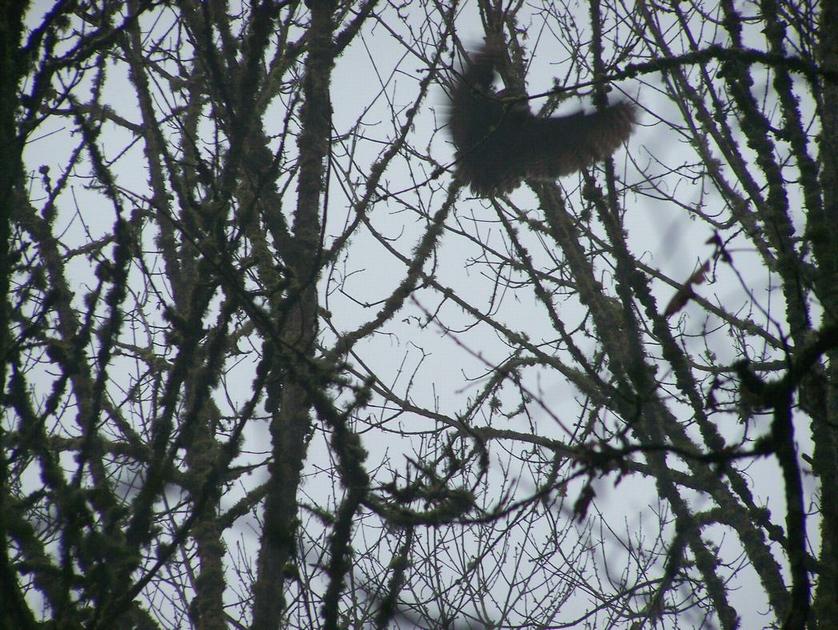
|
|
The next day, January 19, still cold and very foggy, she saw two Owls together in a tree just outside her house. She wrote to me, saying:
"Hi Priscilla,
These were taken Sunday 1/19 between 8:30 am and 10:30 am.
Fir tree in our backyard!
We watched them most of the day."
From that morning, we have these next two photos, taken at 8:40 and 8:43am.

She zoomed in with her camera to get a closer view
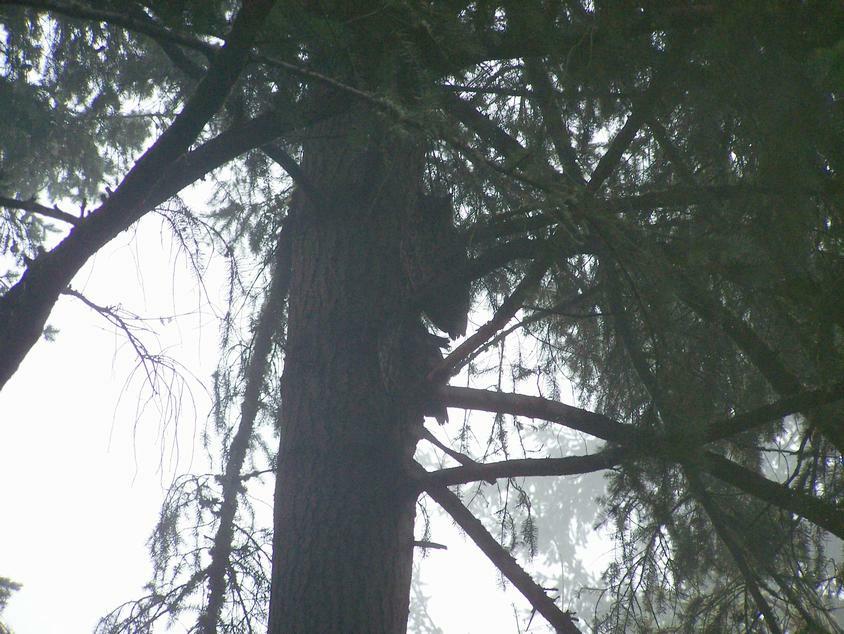
Again, I have tried to compensate for the extreme underexposure of the birds by brightening the image to get more color and detail:
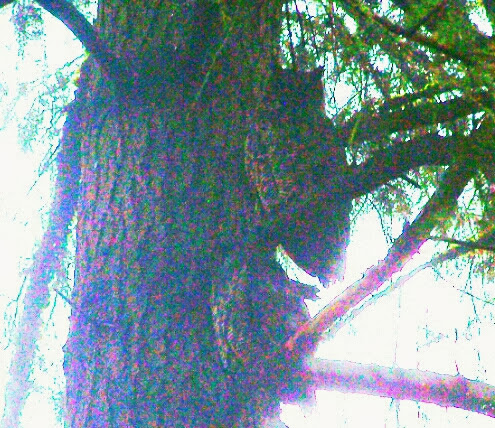
By 10:07, the Owls had changed position and were now side-by-side,
so Beth took a few more photos.
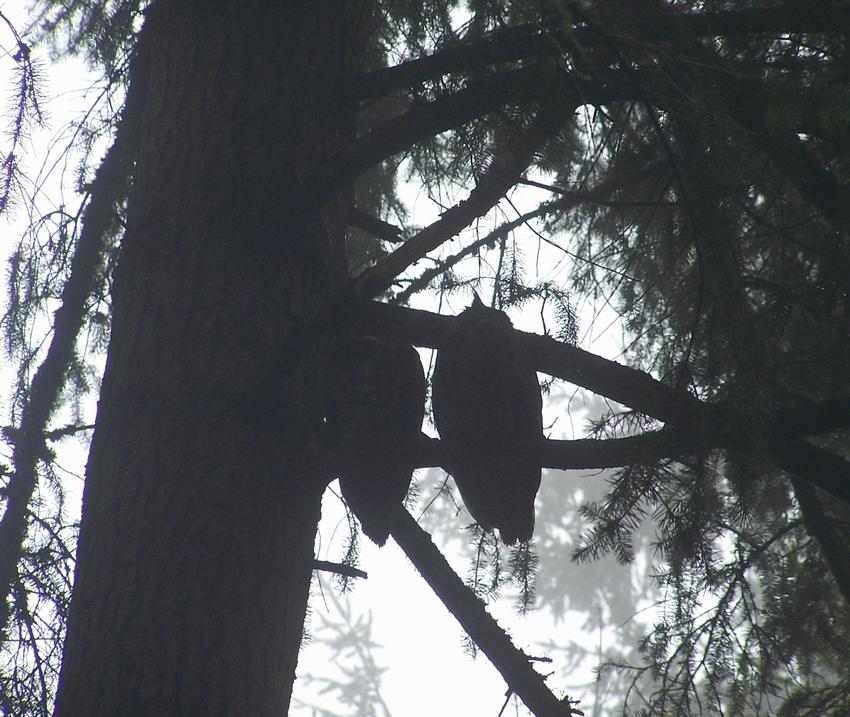
After brightening this photo somewhat, I came up with this:

That white line under the one Owl's chin is highly visible in this photo. I know that a white "V" marking is a field mark of Great Horned Owls, but
with some Great Horned Owls, I've not always seen it. However, it's worth noting that when I was watching a fledgling Great Horned Owl at Delta Ponds along the river in 2012, the one adult I was able to find again and again as it watched over the ever-wandering fledgling, had that same highly visible white line below it's chin. In fact, in 2012, sometimes the only way I was able to find the adult Owl was by looking for that white line amongst all the branches and bark that were camouflaging the Owl. I've always suspected that this year's nest belongs to the same pair of Owls which used to nest near the river, just South of Willamette Oaks retirement center.
|
|
******************** 10:17am ********************
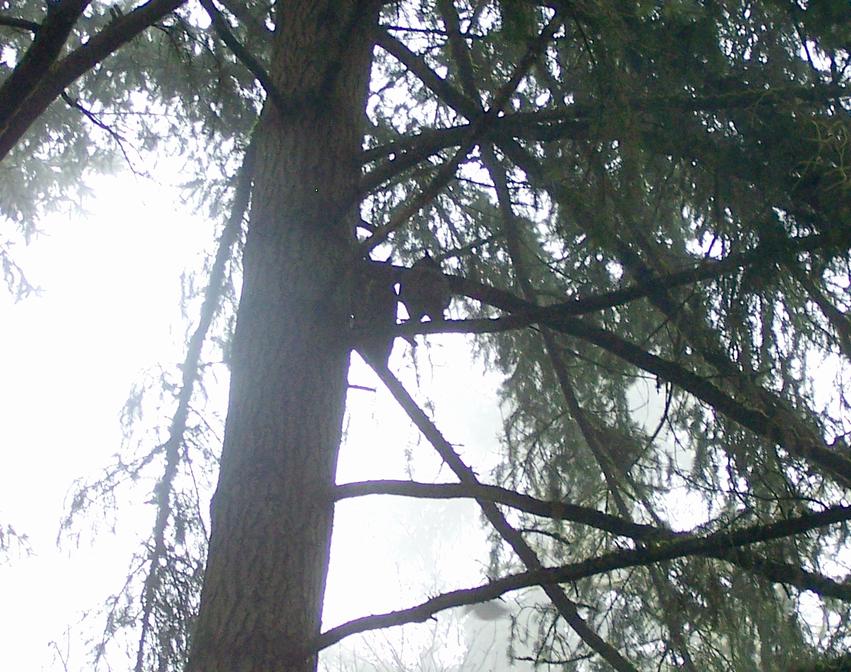
|
|
Beth's note from that same day, continues:
"(Saw) fly-out around 5:00. - just one owl.
I am not sure when the first one left but they were “talking” to each other before he/she(?) flew away...
Really special to say the least..."
|
|
On the 3rd of February, Beth told me that her neighbor had found a Great Horned Owl nest not far from where they live. Her neighbor goes out at night and calls Owls and had been able to discover the nest location
that way.
She took me to the nest site that very afternoon and we were able to find the nest rather easily, even though she was not quite remembering which tree it was in. Here is the first view I had of the nest, and the mother Owl's tail was showing over the edge of the nest!

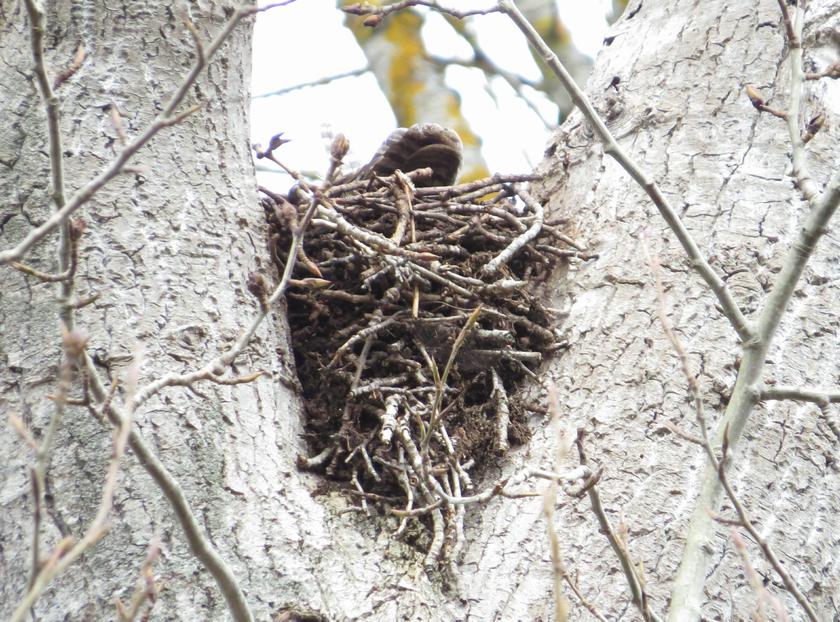
|
|
I am including the following note from Beth because it
provides information relating to the timeline of the Owls nesting.
February 18, 2014
"Hi Priscilla
...
I have not heard a single hoot. I am listening and being extra aware.
I absolutely will contact you w/ any possible sightings or news.
WOW I am loving the Owls!"
This note indicates that by Feb 18, she was no longer seeing or hearing Owls. From what we learned later, we were able to work backwards to conclude that the Owls had laid an egg between Jan 26 and Feb 2,
so it makes sense that her last sighting of the pair was on the 19th,
and that she was no longer hearing them, because the nest site is about an eigth of a mile from her house.
|
|


|
|
I avoided going to the nest more than once a week, so as not to draw attention to the nest. On Feb 16, I returned and this time saw more than just the tail of the female Owl. She was watching me as I approached from the North.
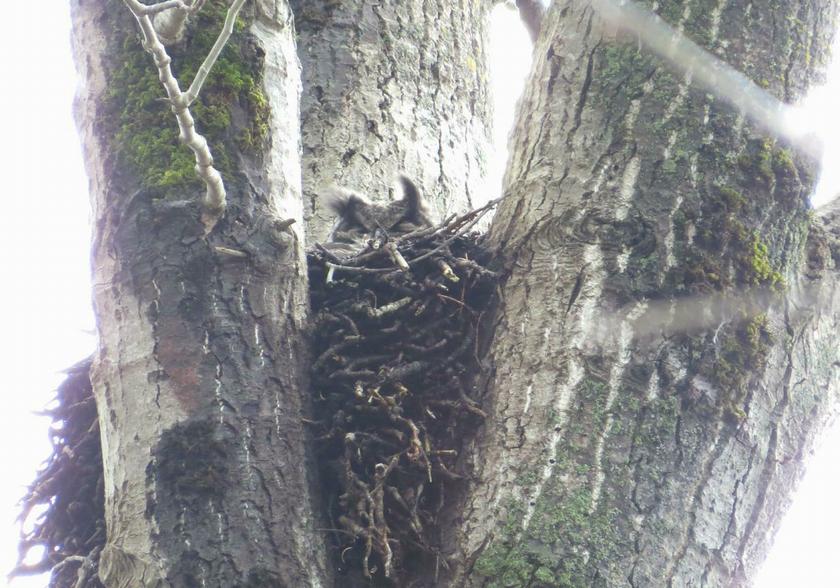
South of the nest 200 feet, there is some higher ground. This spot gives the clearest view of most of the nest.
Mother Owl seemed to relax once I was that far from the nest.

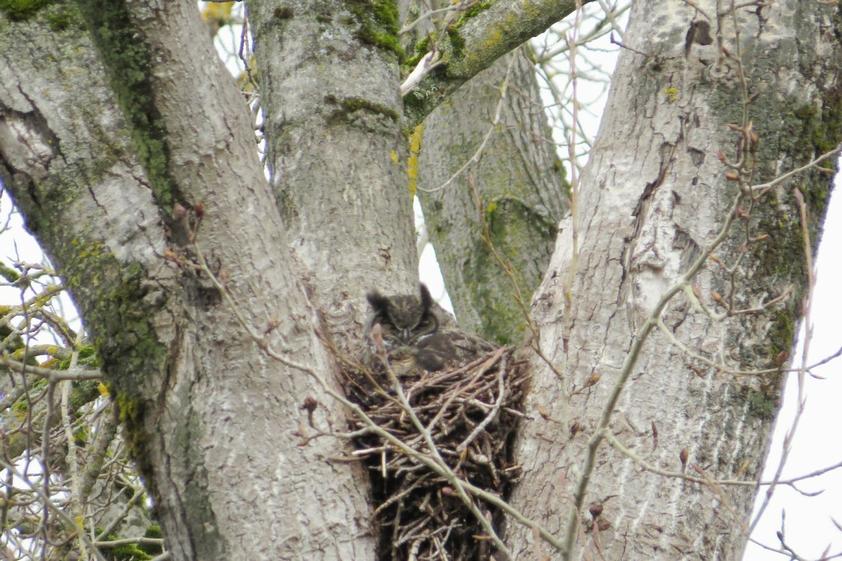
|
|
I was birding in an adjacent area on Feb 27, and though quite far from the nest, I was able to capture an image of the Owl sitting pretty in her nest. Our best guess is that the egg hatched around Mar 1, so it's possible that Mother Owl is already nurturing a chick when I took this picture.
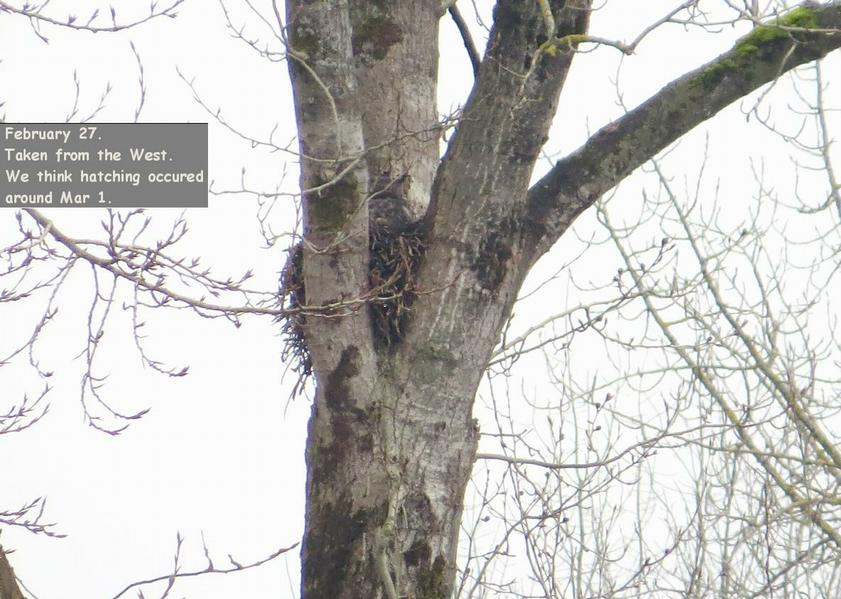
|
|
March 2, 2014
My next visit to the nest was exciting because I got my first glimpse of a new-born Owlet!
That first glimpse was taken from the Northeast direction, at some distance from the nest,
looking through a mesh of trees.

As I approached the nest from the North, I saw that the mother Owl was keeping an eye on me. At first she was simply watchful,
but as I passed the nest on the West side, bringing me closer to the nest tree, she gave me a scowling look.
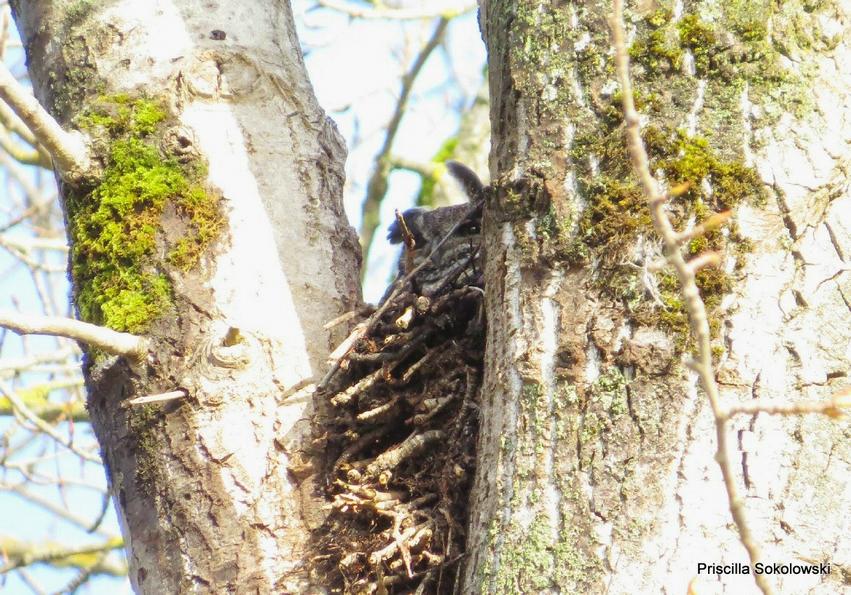
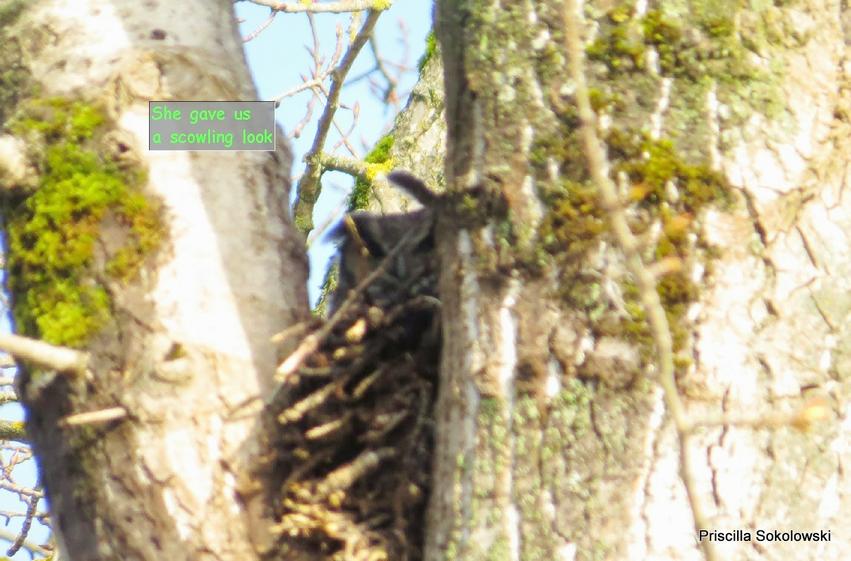
|
|
By the time I reached the higher ground to the South of the nest, Mother Owl appeared to be resting easy again.
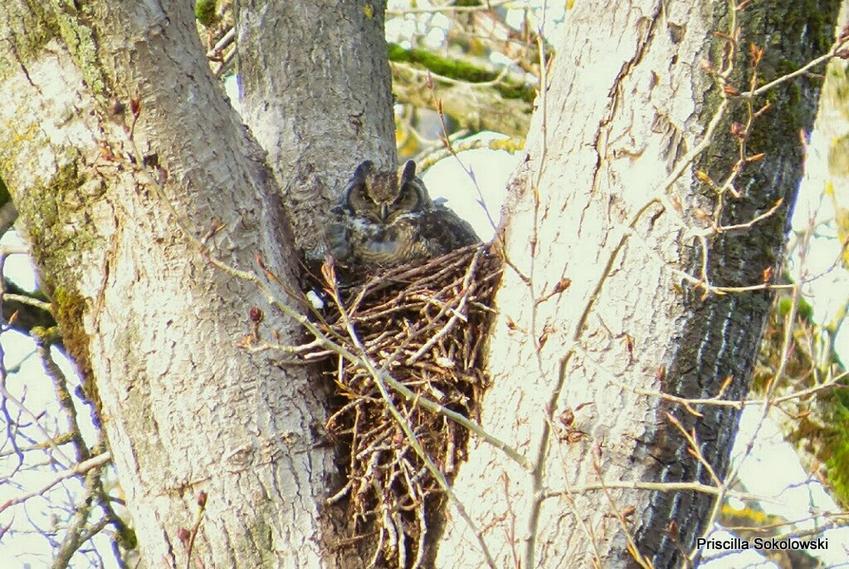
After a while, the mother Owl did some re-arranging of something beneath her in the nest. After getting home and studying
that photo taken from the NE, showing a baby Owl face, I concluded she was arranging the baby Owl's position in the nest.
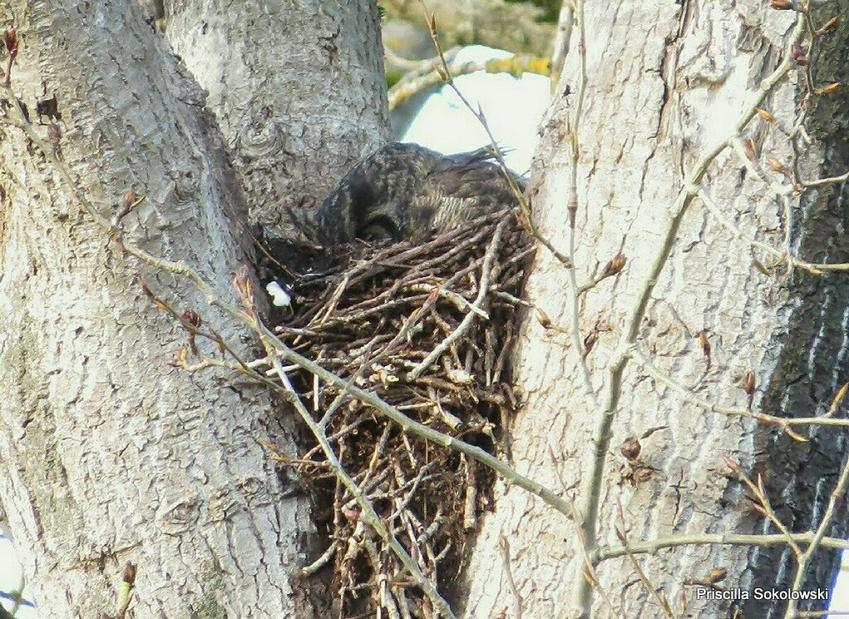
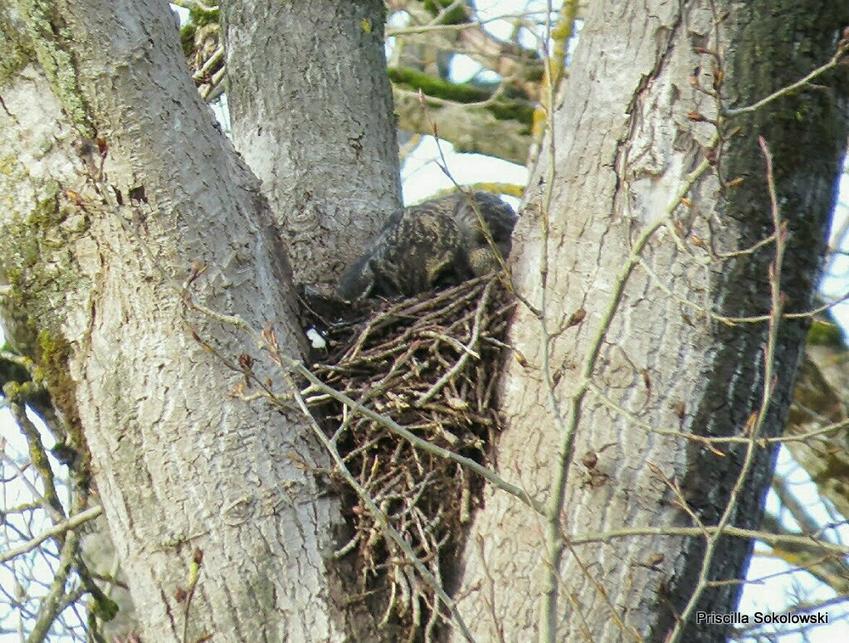
As I was leaving, I photographed the nest from the North again. The mother Owl no longer seemed concerned about my presence.
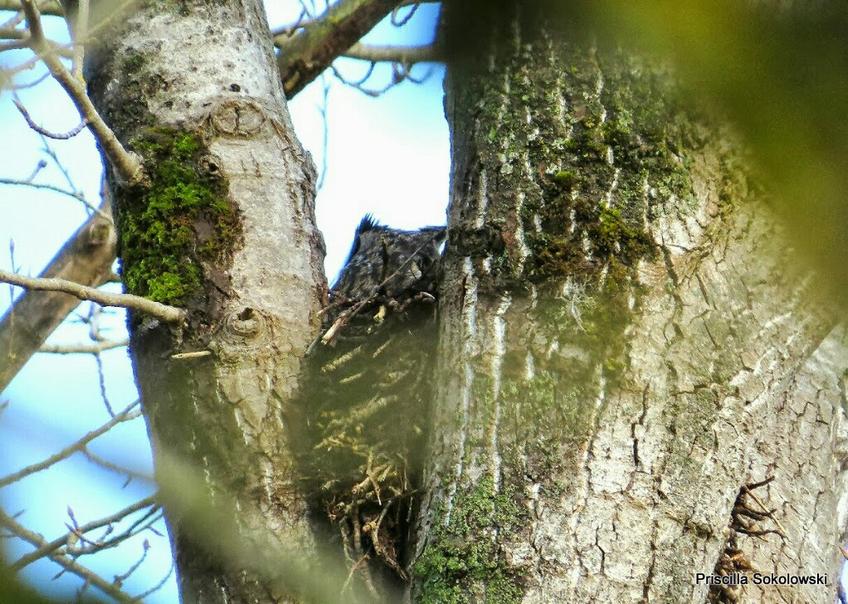
|
|
March 10, 2014
Again, I found the mother Owl watching us, from around the tree trunk as I approached from the North.

Mother Owl seemed pretty relaxed about the whole chick-raising thing.
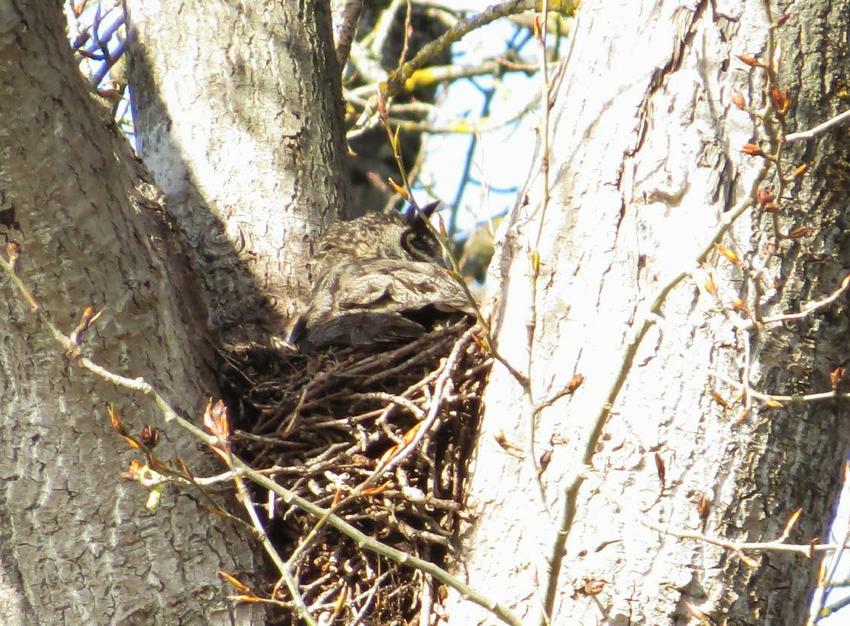
She may have been calm, but she was still watchful.

|
|
In some photos I could see something brown and white to the left of the mother bird. Since we know there was a baby Owl in the nest,
it seems likely that we are seeing some part of the Owlet in the collage below.
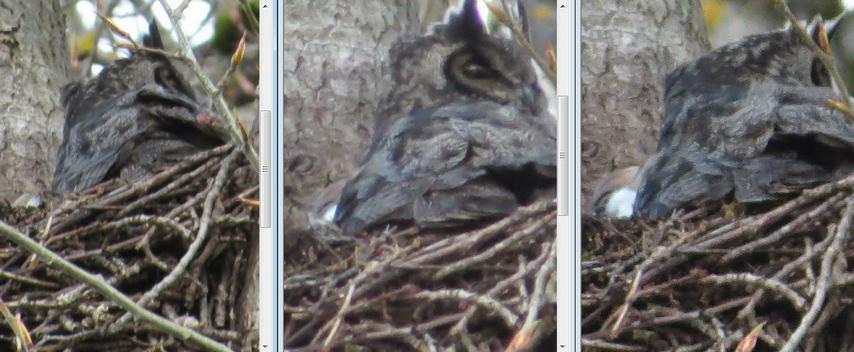
|
|
March 23, 2018
While I intended not to visit the nest more than once a week, I got very involved with driving up to Linn County
during these weeks, making four trips in this interval, to see and photograph Short-Eared Owls which were over-wintering up there,
so I didn't get to the GHO nest between March 10 and March 23, a gap of nearly two weeks.
As can be seen below, the Owlet took advantage of those two weeks to grow into quite a handsome mid-sized bird!
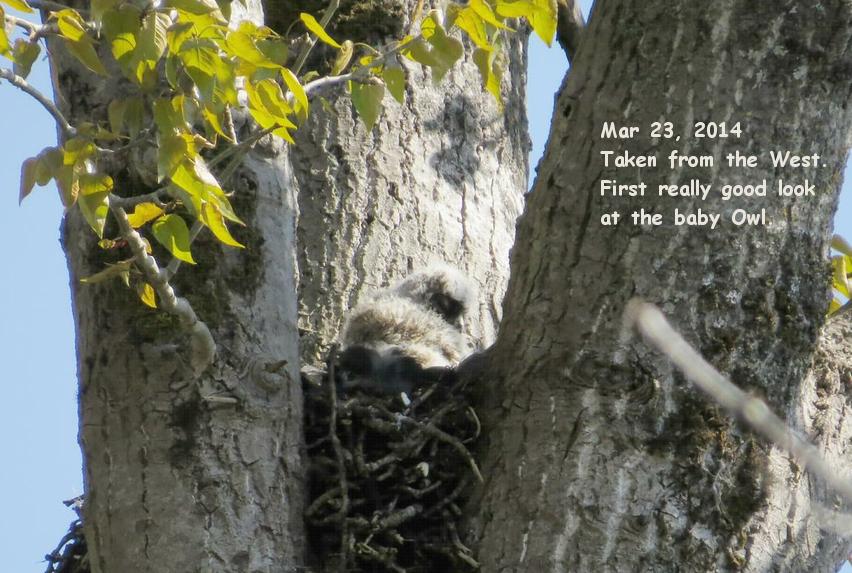
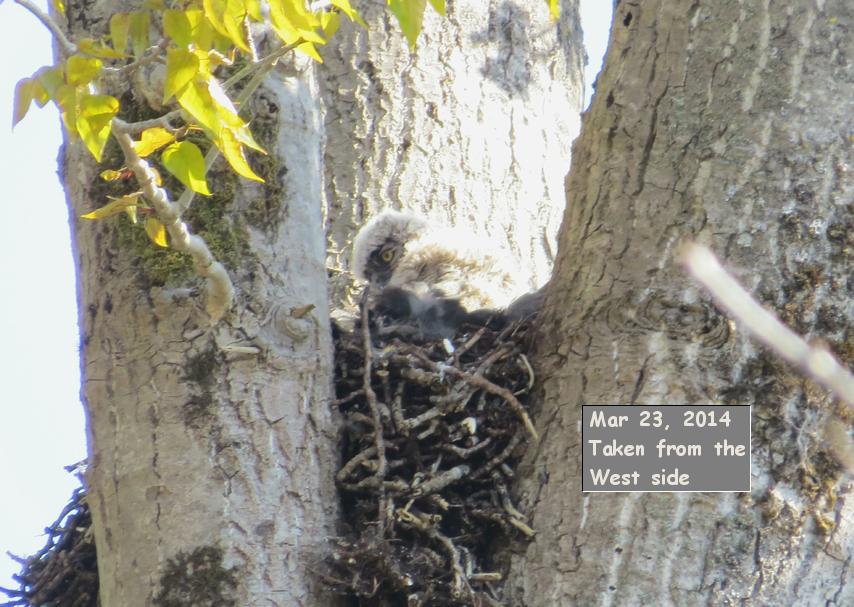
|
|
Now at the age of 3 weeks plus a few days, our Owlet is developing some faint barring on it's back.
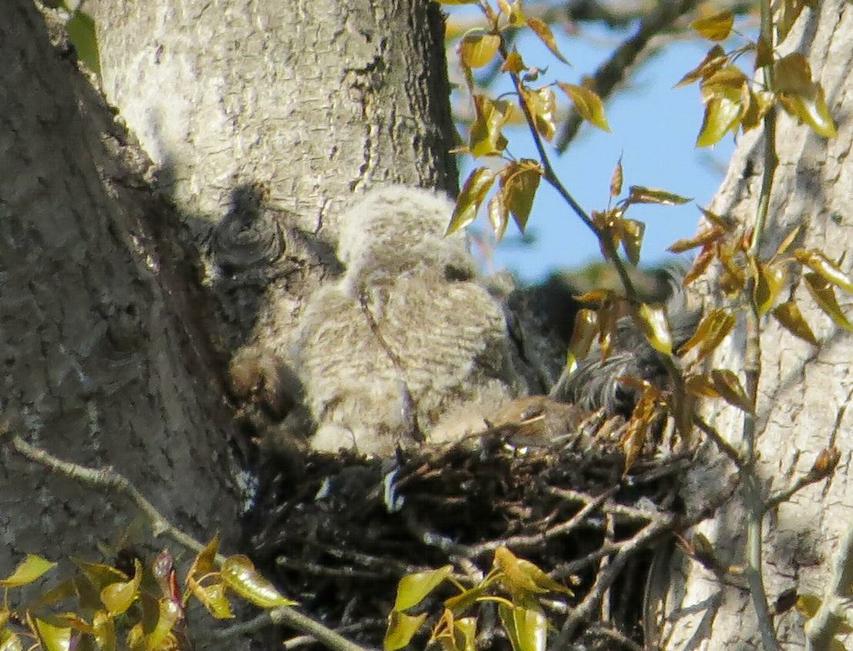
After being mildly active for about half an hour, the baby Owl fell asleep in less than 1 minute
as shown in the following sequence.

|
|
The blue-gray feathers at the right side of the nest appear to be those of a Great Blue Heron.
Great Horned Owls are notorious predators and will bring anything they can kill and carry up to the nest, including skunks and pheasants. In the 1990s I was watching a flimsy Great Horned Owl nest at Mt Pisgah, which ultimately came down during a storm. There was a full Ring-Necked Pheasant carcass among the debris from the fallen nest. The two Owlets in that instance were at an age where they could not fly, but could manage to climb up trees using their bills and talons. I searched around for any feathers or signs of the young Owls having been caught by other predators but found no such signs, so I think the birds survived the destruction of their nest.
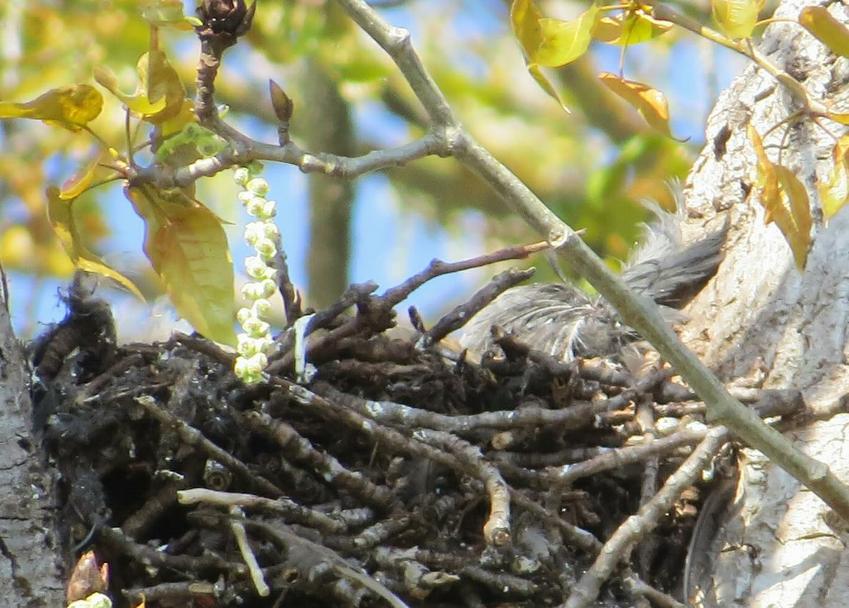
|
|
As I was leaving, I noticed our little Owlet has been learning how to get cagey. It appeared to be cautiously peeking at me as I passed the nest on my departure.
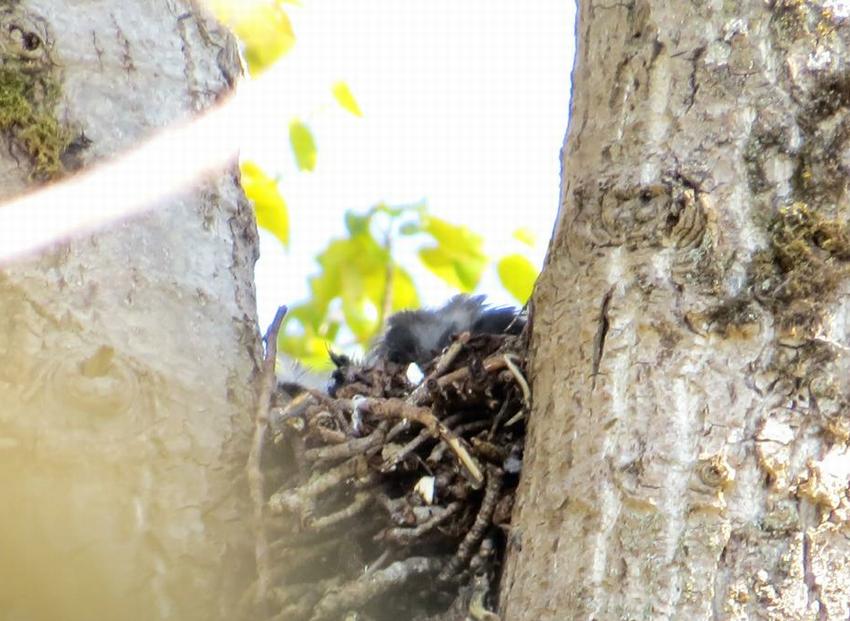
|
|
April 2, 2014; Owlet age just over 4 weeks old.
Our little Owlet moved around in the nest during this visit and even demonstrated standing up on it's own two feet. The barring which was very faint on March 23, at just over 3 wks of age, shows up a little more clearly this time. The only other difference is that the little cutie is perhaps a little larger.

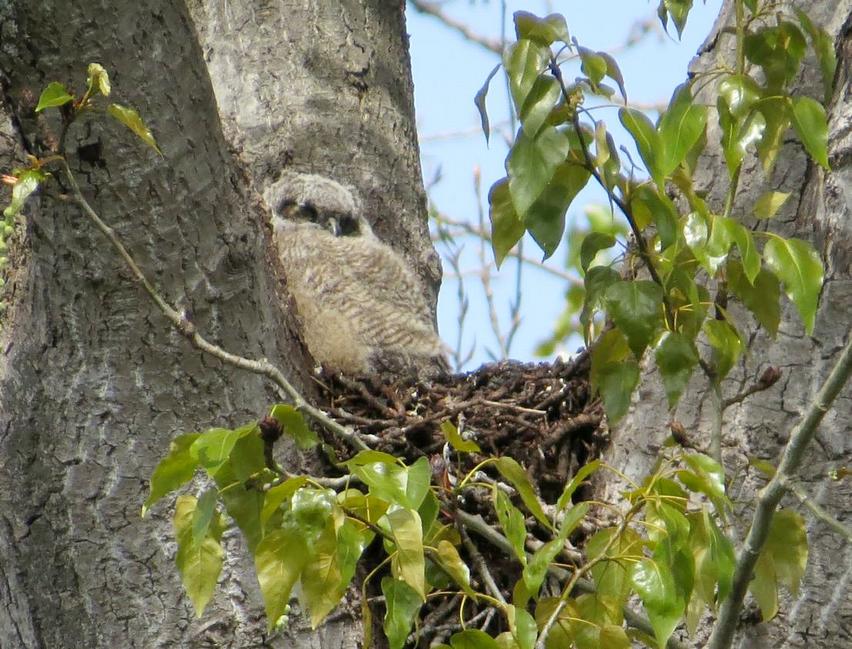

|
|
After photographing the little Owl for a while, I realized that I wasn't seeing any glimpses of the mother bird at all. I figured that if she was not in the nest, then should would be nearby and in a place where she could look down into the nest easily, so she would be higher up in the same tree, or similarly placed in one of the nearest trees. It only took me a few minutes to find her.
The nest is at bottom center of this next photo, and the mother bird is up along the trunk/branch which goes up from the nest, leans to the left, and comes out somewhat towards the camera.
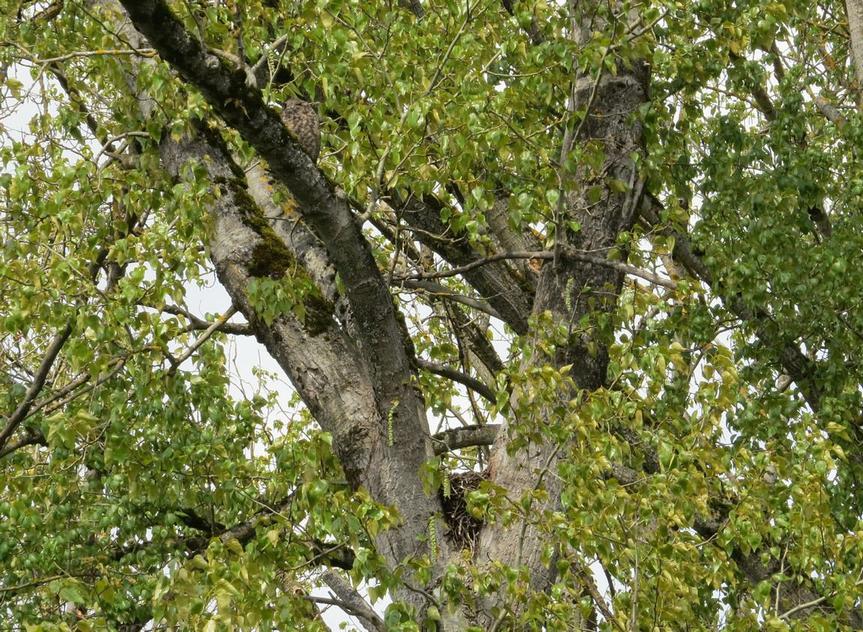
This is the closest I've been to an adult Great Horned Owl since getting into bird photography two years ago. I'm thrilled to get these photos!
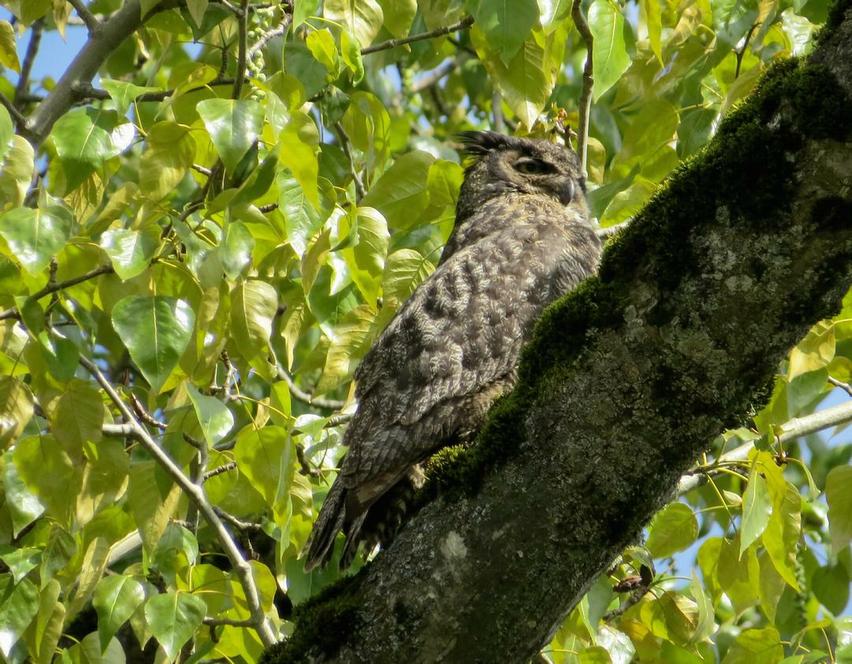
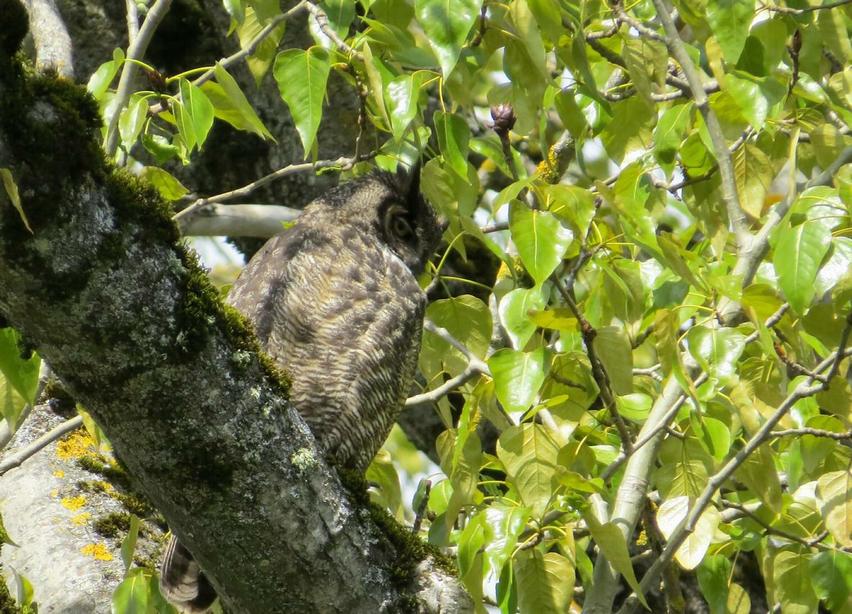
My phone rang while I was taking this next picture. The Owl gave me a long look, but did not otherwise seem too bothered.
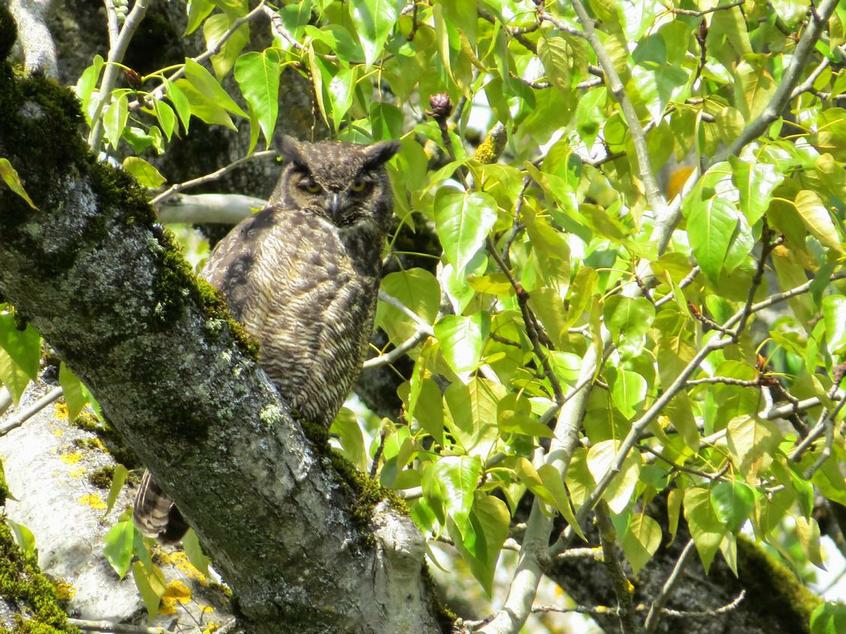
|
|
April 18, 2014; just under 7 weeks of age
It was more than two weeks before I got back to the nest. In the interim, I had been in Burns attending a Migratory Birding Festival for a long weekend. Apparently that was the weekend that the young Owl (at age 6 weeks) began exploring beyond the confines of the nest. A volunteer cleaning up the grounds, and who lives in a house within site of this nest, told us that for a few days the Owlet climbed only one foot up the tree trunk from the nest, but in subsequent days, increased the range of it's explorations. Reference books put this "branching" behavior at six weeks of age, which is consistent with our estimated birthday of March 1.
After going from the North, to the West and South sides of the nest it was clear that the baby Owl was not in it. I began scanning the nearby branches in the nest tree and adjacent trees with my binoculars. There was a pretty nice breeze blowing that day, so even though the leaves of the trees had grown large, the wind blew some leaves aside at just the right moment, giving me a glimpse of the top of the baby Owl's head and it's eyes for just a moment. I situated myself where I could see more of the little bird and got some very nice photos.
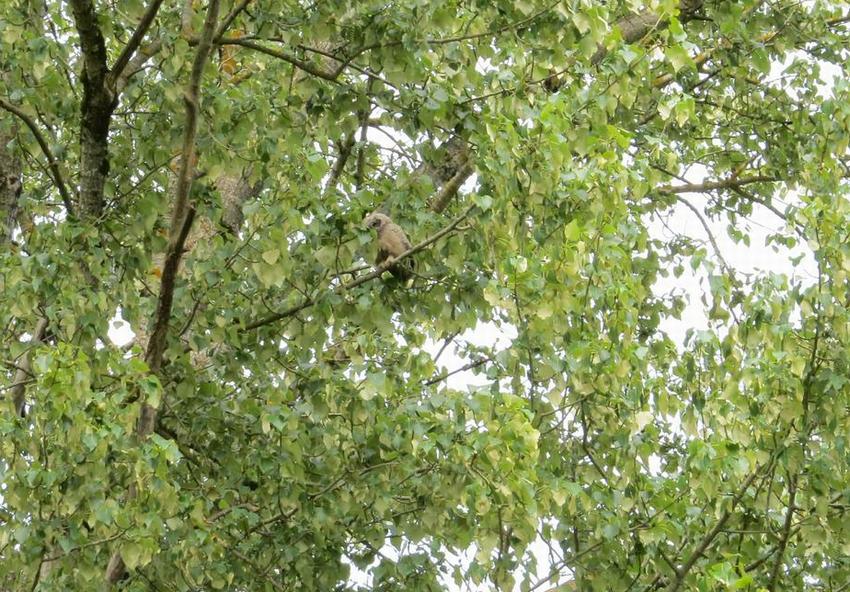

This next picture shows that the Owlet's wing feathers are getting some darker markings.

|
|
When the baby Owl became more aware of my presence, it's eyes got wide open for a short time.

The beginnings of ear tufts are visible in some of this day's photos.
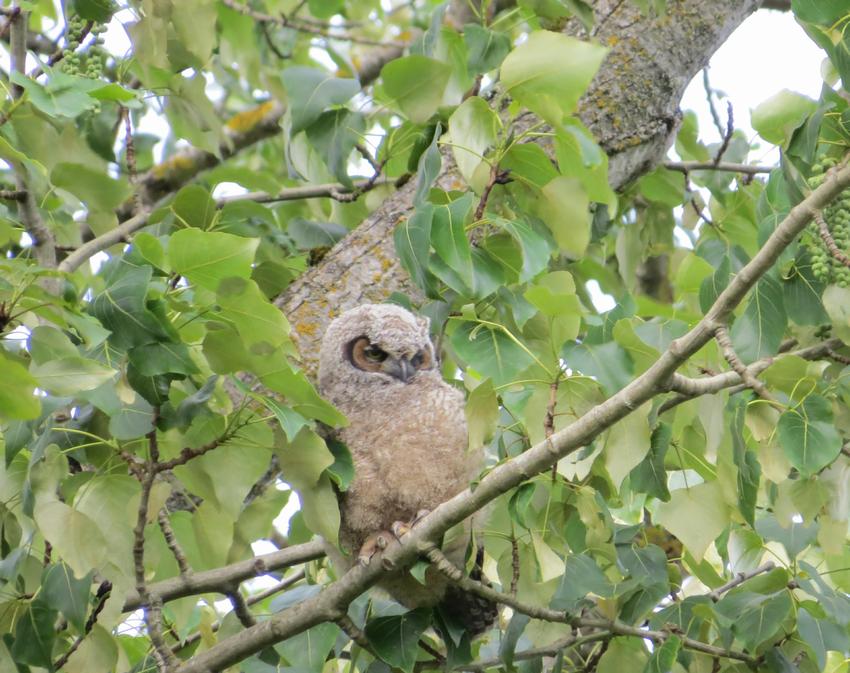
|
|
Our little friend still tires quickly during daylight hours and took a quick nap before we left.

I love this next photo because it appears as if the baby Owl is playing peek-a-boo with me.
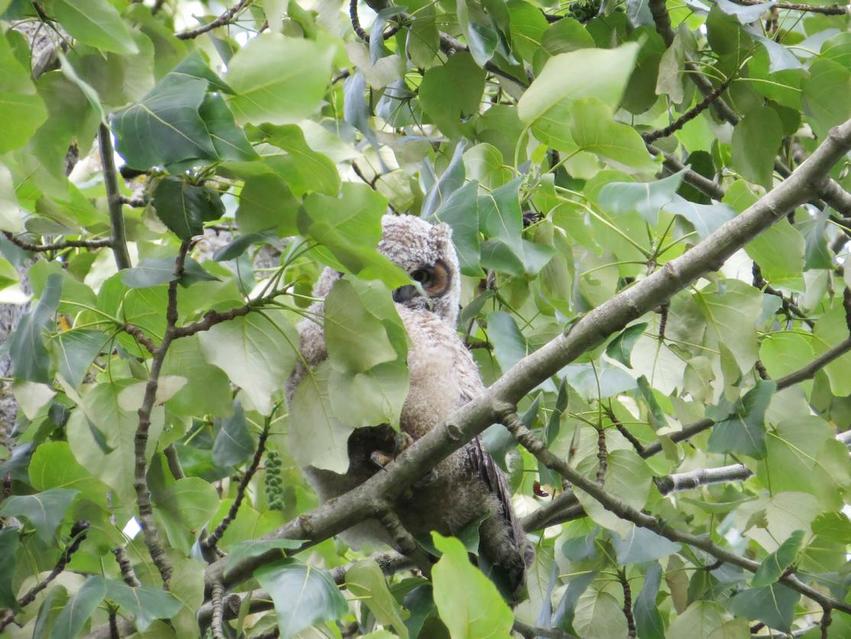
|
|
We spent considerable time looking for an adult Owl, but did not find one. The volunteer said she and others had seen one a few times, in the trees nearby. She told us that Lauri Holts of the Parks department had instructed all the volunteers to keep the location of the nest a secret,
but some women with children, who we encountered coming into the area as we were leaving, told us one of the volunteers had told them about the nest. So I guess word about the nest is getting out now. I hope this doesn't make for problems for the baby Owl before it learns to fly.
|
|
May 16, 2014
I haven't been back to the nest since April 18.
Owlet is over 10 weeks old by now and should be able to do some flying.
I do hope to go to the nest area very soon, near sunset, to just sit and watch for activity as the sky darkens.
In 2012, when I was following a fledgeling Great Horned Owl, the little one would start stretching it's wings
and moving about on a branch before it was dark out. If our little bird does the same thing,
it might not be hard to spot where it is.
I will update this page as soon as I have something new to report,
whether I find any of the Owls or not.
|
|